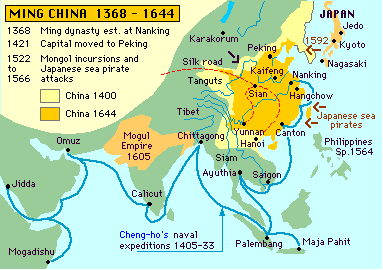
Click to expand: Map1, Map2
| China |

Click to expand: Map1, Map2 |
The north where Chinese civilization began, focuses on the Yellow River. It is an area subject to the extreme heat and frequent droughts in summer and floods in spring. Travel is mainly by land with horses and mules. The diet is based on wheat (bread or noodles) rather than rice.
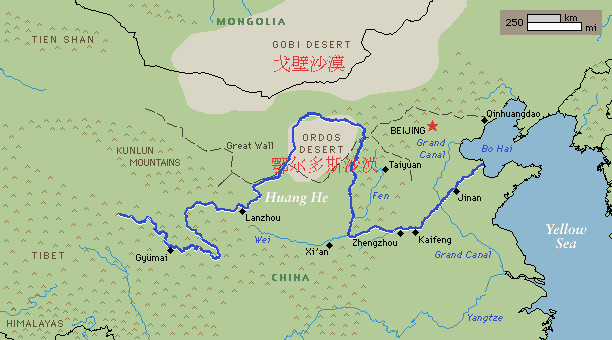
Along the river there are two regions of historic importance: the North China Plain which extends lies between Zhengzhou and the sea and the high Loess plateau further upriver, with the Ordos and Gobi deserts to the north and the Wei river to the south. In ancient times, this region was the meeting zone between the nomadic herders of the Mongolian steppes and the farming communities of what would become China. The origins of the empire lay in this area - especially around Xi’an on the silk road to the west.

Further south, Central China and the Yangzi River region are separated from other regions by mountains and extensive wetlands. The river, its tributaries and lakes are the focus of life and economics. Rice and fish form the staple diet. Up river, past the Three Gorges, there is the Sechuan Basin, a rich, fertile and self-sufficient area whose principal cites are Chongging and Chengdu. Down river, cities, such as Wuhan and Nanjing (and later Shanghai) have economies tied to water-borne transportation and commerce.
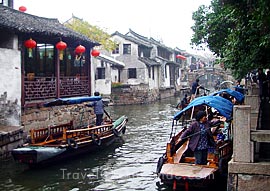 The Shanghai area is criss-crossed with canals and irrigation ditches (map,
aerial photo). Soochow creek connects Shanghai to Suzhou, an ancient city of bridges and canals which further links to the 1800 km Grand Canal going from Beijing to Hangzhou. Between Suzhou and Shanghai, Zhouzhuang, is known as the Venice of the Orient. The importance of water travel is evident in Pippo's letters describing a weekend outing to ZikaWei, a Jesuit settlement, only 5 miles from the center of Shanghai: half the trip will be done by houseboat.
The Shanghai area is criss-crossed with canals and irrigation ditches (map,
aerial photo). Soochow creek connects Shanghai to Suzhou, an ancient city of bridges and canals which further links to the 1800 km Grand Canal going from Beijing to Hangzhou. Between Suzhou and Shanghai, Zhouzhuang, is known as the Venice of the Orient. The importance of water travel is evident in Pippo's letters describing a weekend outing to ZikaWei, a Jesuit settlement, only 5 miles from the center of Shanghai: half the trip will be done by houseboat.
Finally, the southeast coast region from Guangzhou (Canton) to Hangzhou, is turned towards the ocean, both for fishing and trade. Seafoods and tropical fruits dominate the diet. It is dominated by ethnic people not fully identifiable as Han. This region will first experience Western impact with missionaries, the Opium War and Treaty ports such as Macau, Hong Kong & Shanghai.

After this period, Chinese history is often described as a succession of dynasties which provide political continuity between periods of turmoil or domination by foreign peoples. Most often the invaders adopt local culture and are assimilated into the native Han population.
| ... - 1000 BCE |
1000 - 0 BCE |
0 - 1000 CE |
1000 - 2000 CE |
|---|---|---|---|
|
Xia (2100-1600 BCE) Shang (1600-1000 BCE) |
Chou (1000-256 BCE) |
Han (...-220)
Three Kingdoms Sui - 30 years Tang (618 - 907) |
Song (960 - 1270)
Mongols (1270 - 1370) Ming (1370 - 1640) Manchu (1640 - 1911) |
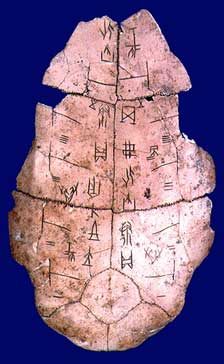 According to legend, the first dynasty was the Xia (ca. 2100-1600 BCE) from Xi'an upstream from the Neolithic settlements; but the written history of China begins with the Shang Dynasty (1600-1050 BCE) [see map]. Two important events mark this period: development of a writing system, as revealed by inscriptions found on tortoise shells and oracle bones, and the use of bronze metallurgy. Major sites include Zhengzhou, and Anyang, the capital from about 1300 BCE.
According to legend, the first dynasty was the Xia (ca. 2100-1600 BCE) from Xi'an upstream from the Neolithic settlements; but the written history of China begins with the Shang Dynasty (1600-1050 BCE) [see map]. Two important events mark this period: development of a writing system, as revealed by inscriptions found on tortoise shells and oracle bones, and the use of bronze metallurgy. Major sites include Zhengzhou, and Anyang, the capital from about 1300 BCE.
The Shang of China are contemporary to the Babylonians. The Chinese golden age of Confucius (around 500 BCE) wil parallel that of Greece with Athens, Aristotle and Pericles.
Other civilizations arose before the Chinese, for example: the Sumerians who developped cuneiform writing around 3500 BCE and were displaced by the Assyrians ca. 2000 BCE, the Minoan empire on Crete which lasted from 3000 to 1100 BCE and the Indus Valley in Pakistan which flourished in 2600-1900 BCE. The Egyptians also predate the Shang; they built the pyramids and the Sphinx around 2500 BCE. But no civilization would last as long as the Chinese and survive into modern times.
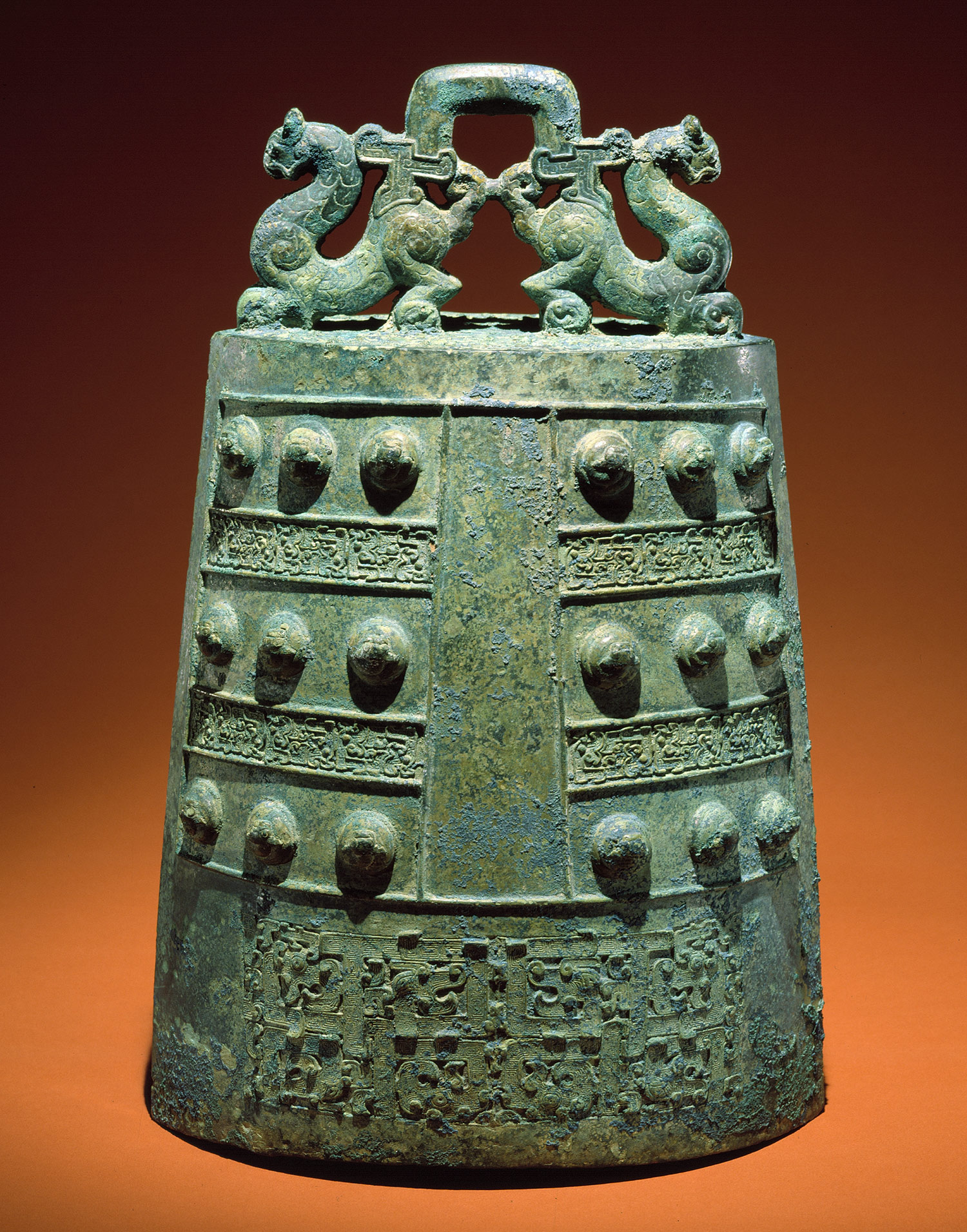 This next period saw the development of modern writing as well as the literature and philosophy of traditional Chinese culture. The Zhou were a people who lived west of Shang, and the Zhou leader, king Wu, had been appointed "Western Protector" by the Shang. He went on to defeat them at the Battle of Muye. Sharing the language and culture of the Shang, the early Zhou rulers, through conquest and colonization, gradually
extended Shang culture south to the Yangtze.
This next period saw the development of modern writing as well as the literature and philosophy of traditional Chinese culture. The Zhou were a people who lived west of Shang, and the Zhou leader, king Wu, had been appointed "Western Protector" by the Shang. He went on to defeat them at the Battle of Muye. Sharing the language and culture of the Shang, the early Zhou rulers, through conquest and colonization, gradually
extended Shang culture south to the Yangtze.
The Zhou's early decentralized rule was proto-feudal, based more on familial ties than on feudal legal bonds. As time went on, the Zhou amalgam of city-states became progressively centralized with greater control over local governments and agricultural taxation.
Later, during a time known as the Spring and Autumn Period (770-475 BCE), the central authority of the state collapsed - see map. The situation was aggravated by the invasion of other peoples from the northwest, such as the Qin, forcing the Zhou to move their capital east to Luoyang. Local military leaders begin to assert their power and the country broke up into hundreds of small domains, which separately became vigorous and expansive, while the Zhou kings were reduced to ruling a small county on the Huang He River: Zone 1 on the map. The next dynasty will arise from Qin, in the west around Baoji. Note finally that the Viet occupy all of southern China.
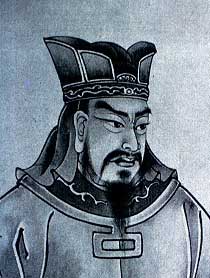
Sun Tzu |
These times, though marked by disunity and civil strife, witnessed an unprecedented era of cultural prosperity--the "golden age" of China. The atmosphere of reform and new ideas was attributed to the struggle for survival among warring regional lords who competed in building strong and loyal armies and in increasing economic production to ensure a broader base for tax collection. Commerce was stimulated through the introduction of coinage. Iron came into general use, making possible not only the forging of weapons of war but also the manufacture of farm implements. Public works on a grand scale--such as flood control, irrigation projects, and canal digging--were executed. Enormous walls were built around cities and along the broad stretches of the northern frontier. Sun Tzu, a wily general of the King of Wu, is said to have written The Art of War at this time. | |
| So many different philosophies developed that the era is often known as that of the Hundred Schools of Thought. It is responsible for many of the great classical writings. This is the period of Confucius, Taoism and Legalism (More info..). |
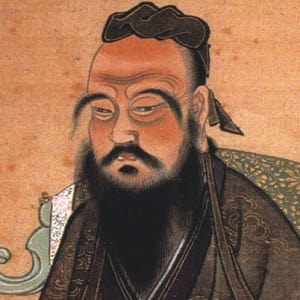
Confucius |
|
| After further political consolidation, seven prominent states remained by the end of 5th century BC, and the years in which these few states battled each other are known as the Warring States Period (map). Though there remained a nominal Zhou king until 256 BC, he was largely a figurehead and held little real power. Note on this map the increased size of Qin from the previous period. | ||
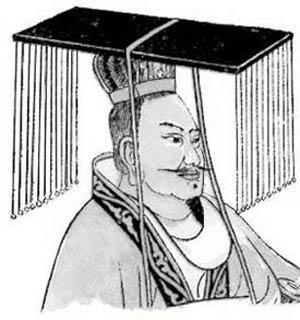 China was unified for the first time in 221 B.C. when the western state of Qin (or Ch'in whence China), finally subjugated the last of its rivals.
Their king then took the title Shi Huangdi (First Emperor) and imposed Qin's centralized, bureaucratic system on his new empire. Centralization, was focused on standardizing legal codes and procedures, the forms of writing and coinage, and the pattern of scholarship. The ruling philosophy was Legalism which advocated draconian laws and ruthless methods to suppress dissent and achieve unification. The emperor banished or put to death dissenting Confucian scholars and burned their books. At the height of its power, the Qin Dynasty had a population of about 40 million people ( map ).
China was unified for the first time in 221 B.C. when the western state of Qin (or Ch'in whence China), finally subjugated the last of its rivals.
Their king then took the title Shi Huangdi (First Emperor) and imposed Qin's centralized, bureaucratic system on his new empire. Centralization, was focused on standardizing legal codes and procedures, the forms of writing and coinage, and the pattern of scholarship. The ruling philosophy was Legalism which advocated draconian laws and ruthless methods to suppress dissent and achieve unification. The emperor banished or put to death dissenting Confucian scholars and burned their books. At the height of its power, the Qin Dynasty had a population of about 40 million people ( map ).
Shi Huangdi destroyed the fortifications that had previously separated the warring states; however, the fortifications in the north were connected making a 2000 km wall to fend off barbarian intrusion; this was a precursor to the present Great Wall which was exended to 5,000 km during the Ming Dynasty.
Shi Huangdi died 11 years after unification and was buried in a lavish tomb with an army of 8000 life-size terracotta soldiers. The tomb was discovered in 1974.
Wu Ti also led many campaigns against the Huns (Hsiung-Nu in chinese) and extended the empire to the west making possible caravan traffic across Central Asia to Antioch, Baghdad, and Alexandria. This was the "silk route" used to export Chinese silk to the Roman Empire. Chinese armies also invaded and annexed parts of Korea and Vietnam [Vietnam would only regain its independence 800 years later]. However, continued raids from the north caused a population shift to the east and south. The capital was moved to Luoyang around 25 CE. By A.D. 220 the Han empire had collapsed and was followed by a long period of disunity and civil war.
 For the longest time, silk production remained a Chinese secret. It is obtained by unraveling the cocoon of the silk moth just before the moth hatches. The cocoons are boiled to kill the moth and loosen the filament which is then unwound and combined into threads to be woven into cloth. Each cocoon is composed of a single filament about 1000 m long. About 100 cocoons are needed for a tie and 650 for a blouse.
For the longest time, silk production remained a Chinese secret. It is obtained by unraveling the cocoon of the silk moth just before the moth hatches. The cocoons are boiled to kill the moth and loosen the filament which is then unwound and combined into threads to be woven into cloth. Each cocoon is composed of a single filament about 1000 m long. About 100 cocoons are needed for a tie and 650 for a blouse.
Through raids and smuggling, the technology first leaked out to Japan, then India. Then around 550, the Byzantine emperor Justinian recruited two Persian monks and sent them into China as industrial spies. Two years later, the monks returned to Constantinople (now Istanbul) with silkworm eggs and mulberry seeds concealed within their hollow bamboo canes. About 600 years later, crusaders brought the secret of silk production to western Europe. |
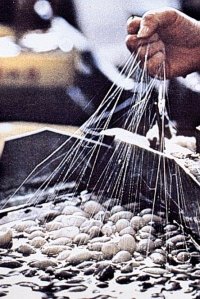 |
It began with the era of the Three Kingdoms (220-265 CE) set up by Han generals in the three chief economic areas of China: Wei around the old capital in the north, Wu around the lower Yangzi, and Shu in the Sichuan Basin. In later times, fiction and drama greatly romanticized the reputed chivalry of this period.
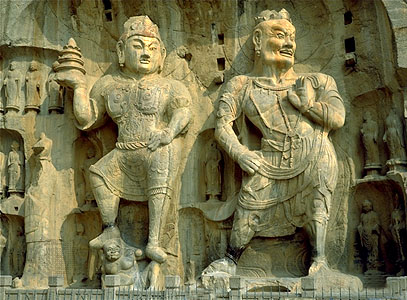 The period between 386 and 581 CE in Chinese history is conventionally called the Northern and Southern Dynasties, when the North - under the control of the Tuoba (a Mongol people) - was culturally connected with the Chinese dynasties established in Jiankang (Nanking). The Northern Wei rulers were ardent supporters of Buddhism. In 477, the Emperor Hsiao-Wen had built the Shaolin Monastery near the capital at Luoyang. The first abbot was an Indian master who came to China to spread Buddhist teachings. The Shaolin temple became the birthplace of Kung Fu and Zen Buddhism. The massive buddhas in the nearby Longmen caves also date from the same era. Similarly, in the south, monks propagated Buddhist ideas that were compatible with Daoist philosophy.
The period between 386 and 581 CE in Chinese history is conventionally called the Northern and Southern Dynasties, when the North - under the control of the Tuoba (a Mongol people) - was culturally connected with the Chinese dynasties established in Jiankang (Nanking). The Northern Wei rulers were ardent supporters of Buddhism. In 477, the Emperor Hsiao-Wen had built the Shaolin Monastery near the capital at Luoyang. The first abbot was an Indian master who came to China to spread Buddhist teachings. The Shaolin temple became the birthplace of Kung Fu and Zen Buddhism. The massive buddhas in the nearby Longmen caves also date from the same era. Similarly, in the south, monks propagated Buddhist ideas that were compatible with Daoist philosophy.
This period also saw a large influx of foreign immigrants, mainly traders or Buddhist missionaries from Central Asia. Some settled in China and held official posts; they adopted the Chinese way of life, but maintained their own social customs.
Notable inventions from this period include: gunpowder (used initially for fireworks) and the wheelbarrow which appeared in Europe 1000 years later.
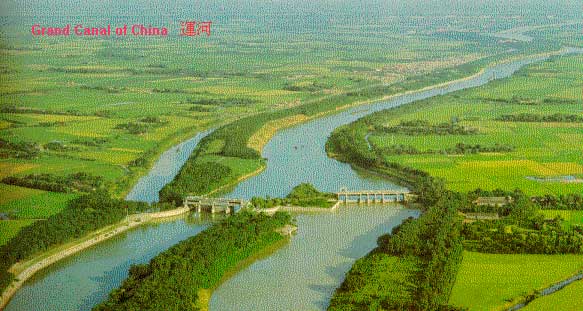
China was reunified again in 589 CE by the Sui from the north. An important achievement of this period was the completion of the Grand Canal to link the Yellow River with the Yangtze basin and facilitate the transport of grain to the northern capital of Luoyang. The initial course of the canal, completed around 605 CE, connected several sections constructed earlier, starting from the Wu Kingdom era (486 BCE). Initially, the canal was roughly 1000 km long. In later years the system would total about 2,500 kilometers and reach Beijing with via pound locks (invented ca. 984).
The Sui rulers were interested in expanding their borders and they began costly military campaigns. They were largely successful in the south. However, after disastrous results against Korea, the last Sui emperor was killed by his generals, and one of them started the next dynasty.
The Tang dynasty (618-906 AD) was a time of relative freedom for women and Wu Chao, a wily court concubine was able to become China's first Empress. Recruited at age 13 for her wit and beauty, she soon gained the favour of the emperor; then that of his son, emperor Gaozong. Later historians described Wu as cunning and ruthless. They say she disposed of a rival by murdering her own son, and then claiming the rival had done it. Wu became the emperor's wife, and when he suffered a stroke, she took over the reins of government. Later, when he died, she may have poisoned the eldest son to continue ruling as regent for the younger. Eventually, she proclaimed herself Ruling Empress as Wu Zetian. The modern view is that she was one of the most able and brilliant of the Chinese emperors. During her 21 years in power, she oversaw the greatest expansion of T'ang military power and strengthened the economy. A devout Buddhist, she founded many monasteries.
Note: Wu Zetian is not to be confused with the Empress Dowager (1835-1908) who was the last effective ruler of Imperial China before it became a republic. |
Empress Wu Zetian
|
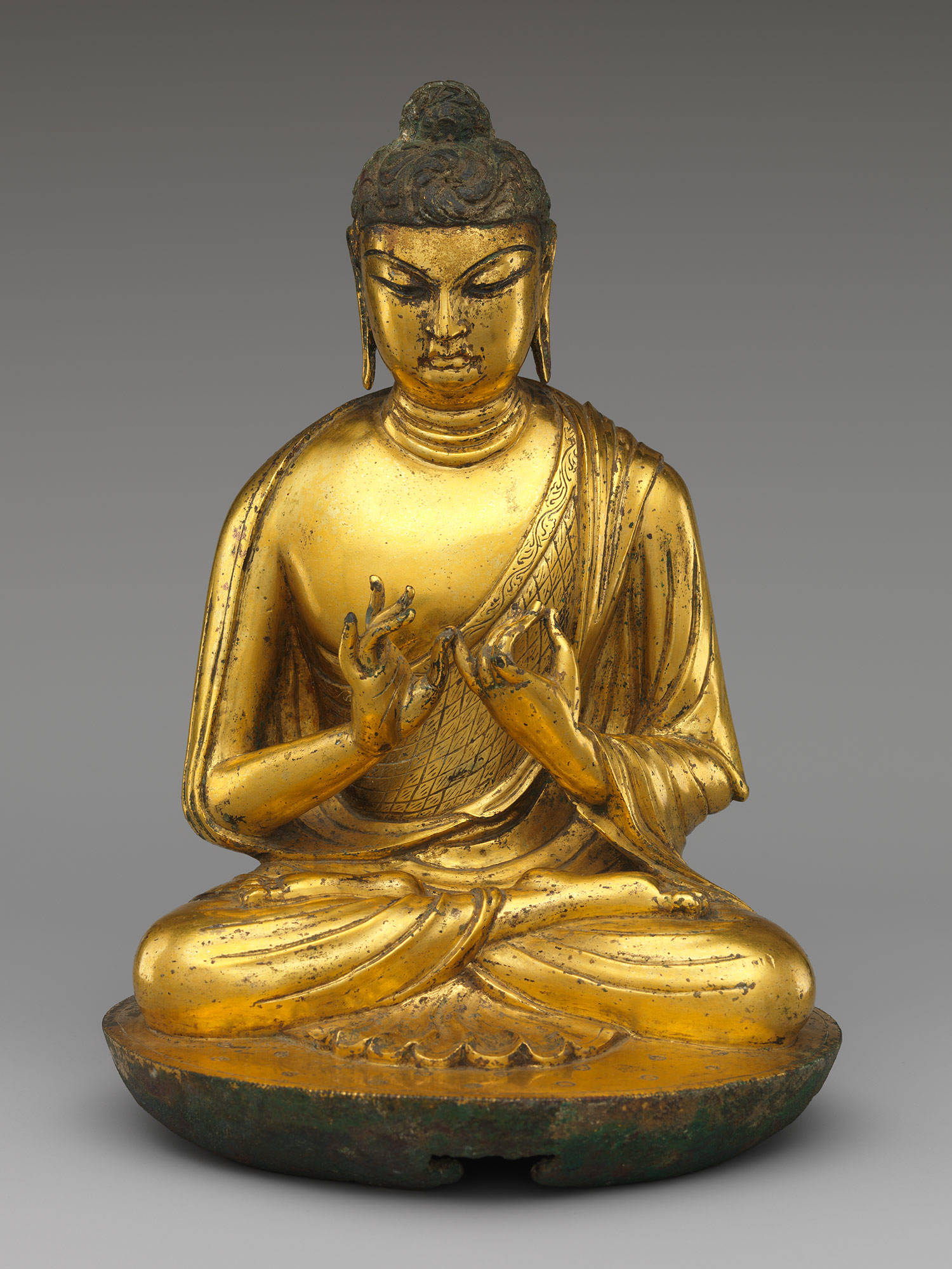 Generally, Buddhism, which originated in India around the time of Confucius, flourished during the Tang period, becoming thoroughly sinicized and a permanent part of Chinese traditional culture.
Generally, Buddhism, which originated in India around the time of Confucius, flourished during the Tang period, becoming thoroughly sinicized and a permanent part of Chinese traditional culture.
This was also a time of momentous social change; the official examination system enabled educated men without family connections to serve as government officials (mandarins), and the recruitment of gentlemen from the south contributed to the cultural amalgamation that had already begun in the sixth century. The Tang also instituted land reform where they gave life plots to the peasant families.
The Tang period was the golden age of literature and art. Block printing was invented, making the written word available to vastly greater audiences. Printing also allowed producition of playing cards and even paper money.
Eventually the usual mix of misrule, court intrigues, and popular rebellions weakened the empire, making it possible for northern invaders to terminate the dynasty in 907. The next half-century saw the fragmentation of China into multiple kingdoms (Map).
During this time, population doubled thanks to expanded cultivation in the south and the importation of a fast-growing Vietnamese strain of rice. The Song dynasty is notable for the development of cities as centers of trade, industry, and maritime commerce. A new group of wealthy commoners --the mercantile class-- arose as education spread, and a market economy began to link the coastal provinces and the interior. Landholding and government employment were no longer the only means of gaining wealth and prestige.
The Song was the first government in world history to issue banknotes or paper money and the first in China to establish a permanent standing navy.
The stability of the period re-enforced the existing social structure. Furthermore, Neo-Confucian philosophers evolved a notoriously conservative (if not outright reactionary) official creed, which stressed the one-sided obligations of obedience and compliance. Consequently, society and economics would remain largely static until the collapse of dynastic China in 1912.
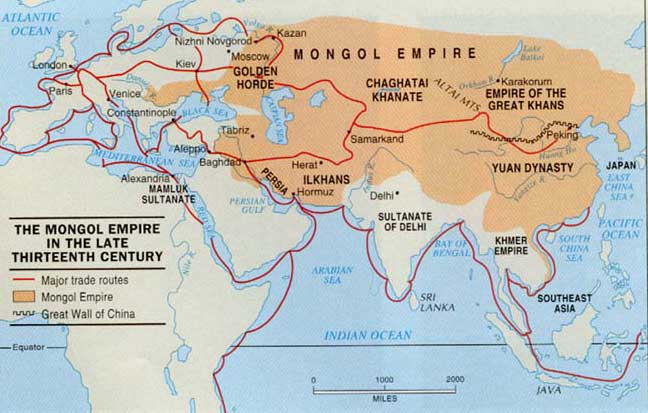
While time of Mongol rule is called a dynasty, it was in fact a government of occupation. The Mongols did use existing governmental structures, but the language they used was Mongol, and the officials in key positions were non-Chinese from other parts of their empire - even an Italian named Marco Polo.
As the Chinese nobility were not allowed to be involved in government, they were free to pursue art and literature. This led to the development of drama, opera and the increased use of the written vernacular.
The first records of travel by Westerners date from this time. In 1271, Marco Polo travelled to China with his father and uncle over the Silk Road. He worked for Kublai Khan for seventeen years before sailing home. He brought back ivory, jade, jewels, porcelain and silk, and told stories about the Chinese use of coal, money and compasses. His autobiography, dictated to Rustichello - a romance writer - in a Genoese gaol, gave Europeans some of their earliest information about China.
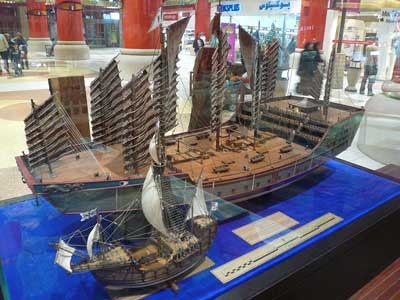 Ming armies reconquered Annam (north Vietnam) and extended the Great Wall to 4,000 miles to keep back the Mongols. The watch towers were redesigned and cannons were added. At its peak, the Ming Wall was guarded by more than one million men. Under the Ming dynasty, China experienced incredible expansion in all areas of economic life: agriculture, industry, commerce, and - new to China - naval exploration.
Ming armies reconquered Annam (north Vietnam) and extended the Great Wall to 4,000 miles to keep back the Mongols. The watch towers were redesigned and cannons were added. At its peak, the Ming Wall was guarded by more than one million men. Under the Ming dynasty, China experienced incredible expansion in all areas of economic life: agriculture, industry, commerce, and - new to China - naval exploration.
At this time, Chinese naval technology was far ahead of the rest of the world. They had invented the rudder and watertight compartments and had established sea routes for trade with Japan and south Asia. Starting in 1405 A.D., the emperor sent Zheng He (or Cheng Ho), a Moslem eunuch slave who became Admiral, on a series of seven naval expeditions that went as far as the east coast of Africa returning with foreign ambassadors and tribute to the Ming court. Zheng He's first fleet included 27,870 men on 317 ships - some over 100m long with 9 masts and manned by 500 men. In total, he traveled more than 50,000 km and visited over 37 countries. The picture above compares one of ZhengHe's ships with a Colombus Caravelle.
